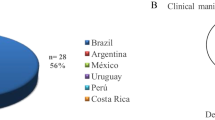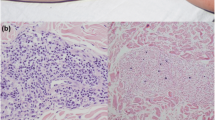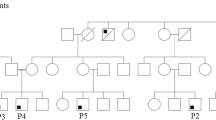CD40 ligand (CD40L) deficiency is an X-linked combined immunodeficiency characterized by impaired class switch recombination. We analyzed clinical and molecular findings in 11 Argentinian patients from seven unrelated families. The mean age at onset of symptoms was 1.1 years (0.5–3.0 years) and the 10 alive patients have a median age of 17 years. We identified two nonsense mutations, including R11X reported as a “hypomorphic” defect, four missense mutations, and one point deletion. Although R11X was associated herein with parvovirus B19-anemia and higher Igs levels as previously described, histoplasmosis and Pneumocystis jiroveci pneumonia were also present. Other so-called “milder” mutation, T254M, was present in three related patients clinically and immunologically undistinguishable from the rest of the cohort. Furthermore, 10 of the 11 patients, having heterogeneous mutations, never had persistent neutropenia, none presented Cryptosporidium sp. infection nor developed liver-biliary tract disease, highlighting the debatable concept of “milder” mutations.
Similar content being viewed by others
REFERENCES
Korthauer U, Graf D, Mages HW, Briere F, Padayachee M, Malcolm S, Ugazio AG, Notarangelo LD, Levinsky RJ, Kroczek RA: Defective expression of T-cell CD40 ligand causes X-linked immunodeficiency with hyper-IgM. Nature 361:539–541, 1993
Di Santo JP, Bonnefoy JY, Gauchat JF, Fischer A, de Saint Basile G: CD40 ligand mutations in X-linked immunodeficiency with hyper-IgM. Nature 361:541–543, 1993
Aruffo A, Farrington M, Hollenbaugh D, Li X, Milatovich A, Nonoyama S, Bajorath J, Grosmaire LS, Stenkamp R, Neubauer M, Roberts RL, Noelle RJ, Ledbetter JA, Francke U, Ochs HD: The CD40 ligand, gp39, is defective in activated T cells from patients with X-linked hyper-IgM Syndrome. Cell 72:291–300, 1993
Allen RC, Armitage RJ, Conley ME, Rosenblatt H, Jenkins NA, Copeland NG, Bedell MA, Edelhoff S, Disteche CM, Simoneaux DK, Fanslow WC, Belmont JW, Spriggs MK: CD40 ligand gene defects responsible for X-linked hyper-IgM syndrome. Science 259:990–993, 1993
Ferrari S, Giliani S, Insalaco A, Al-Ghonaium A, Soresina AR, Loubser M, Avanzini MA, Marconi M, Badolato R, Ugazio AG, Levy Y, Catalan N, Durandy A, Tbakhi A, Notarangelo LD, Plebani A: Mutations of CD40 gene cause an autosomal recessive form of immunodeficiency with hyper IgM. Proc Natl Acad Sci USA 98:12614–12619, 2001
Notarangelo LD, Lanzi G, Peron S, Durandy A: Defects of class-switch recombination. J Allergy Clin Immunol 117:855–864, 2006
Conley ME, Notarangelo LD, Etzioni A: Diagnostic criteria for primary immunodeficiencies. Clin Immunol 93:190–197, 1999
Villa A, Notarangelo LD, Di Santo JP, Macchi PP, Strina D, Frattini A, Lucchini F, Patrosso CM, Giliani S, Mantuano E, Agosti S, Nocera G, Kroczek RA, Fischer A, Ugazio AG, de Saint Basile G, Vezzoni P: Organization of the human CD40L gene: Implications for molecular defects in X chromosome-linked hyper-IgM syndrome and prenatal diagnosis. Proc Natl Acad Sci USA 91:2110–2114, 1994
Seyama K, Nonoyama S, Gangsaas I, Hollenbaugh D, Pabst HF, Aruffo A, Ochs HD: Mutations of the CD40 ligand gene and its effect on CD40 ligand expression in patients with X-linked hyper IgM syndrome. Blood 92:2421–2434, 1998
Blaeser F, Kelly M, Siegrist K, Storch GA, Buller RS, Whitlock J, Truong N, Chatila TA: Critical function of the CD40 pathway in parvovirus B19 infection revealed by a hypomorphic CD40 ligand mutation. Clin Immunol 117:231–237, 2005
Lin Q, Rohrer J, Allen RC, Larché M, Greene JM, Shigeoka AO, Gatti RA, Derauf DC, Belmont JW, Conley ME: A single strand conformation polymorphism study of CD40 ligand. J Clin Invest 97:196–201, 1996
Katz F, Hinshelwood S, Rutland P, Jones A, Kinnon C, Morgan G: Mutation analysis in CD40 ligand deficiency leading to X-linked hypogammaglobulinemia with hyper IgM syndrome. Hum Mutat 8:223–228, 1996
Nonoyama S, Shimadzu M, Toru H, Seyama K, Nunoi H, Neubauer M, Yata J, Ochs HD: Mutations of the CD40 ligand gene in 13 Japanese patients with X-linked hyper-IgM syndrome. Hum Genet 99:624–627, 1997
Garber E, Su L, Ehrenfels B, Karpusas M, Hsu Y-M: CD154 variants associated with hyper-IgM syndrome can form oligomers and trigger CD40-mediated signals. J Biol Chem 274:33545–33550, 1999
Ziegner UHM, Kobayashi RH, Cunningham-Rundles C, Español T, Fasth A, Huttenlocker A, Krogstad P, Marthinsen L, Notarangelo LD, Pasic S, Rieger CHL, Rudge P, Sankar R, Shigeoka AO, Stiehm ER, Sullivan KE, Webster AD, Ochs HD: Progressive neurodegeneration in patients with primary immunodeficiency disease on IVIG treatment. Clin Immunol 102:19–24, 2002
Levy J, Español-Boren T, Thomas C, Fischer A, Tobo P, Bordigoni P, Resnick I, Fasth A, Baer M, Gómez L, Sandera EA, Tabone M-D, Plantaz D, Etzioni A, Monafo V, Abinum M, Hammarstrom L, Abrahamsen T, Jones A, Finn A, Klemola T, DeVries E, Sanal O, Peitsch MC, Notarangelo LD: Clinical spectrum of X-linked hyper-IgM syndrome. J Pediatr 131:47–54, 1997
Winkelstein JA, Marino MC, Ochs HD, Fuleihan R, Scholl PR, Geha R, Stiehm ER, Conley ME: The X-linked hyper-IgM syndrome. Medicine 82:373–384, 2003
Lee W-I, Torgerson TR, Schumacher MJ, Yel L, Zhu Q, Ochs HD: Molecular analysis of a large cohort of patients with the hyper IgM syndrome (HIGM). Blood 105:1881–1890, 2005
de Vries E, Noordzij JG, Davies EG, Hartwig N, Breuning MH, Van Dongen JJM, Van Tol MJD: The 782C->T (T254M) XHIM mutation: Lack of a tight phenotype–genotype relationship. Blood 94:1488–1490, 1999
Litinskiy MB, Nardelli B, Hilbert DM, He B, Schaffer A, Casali P, Cerutti A: DCs induce CD40-independent immunoglobulin class switching through BLyS and APRIL. Nat Immunol 3:822–829, 2002
den Dunnen JT, Antonarakis SE: Mutation nomenclature extensions and suggestions to describe complex mutations: A discussion. Hum Mutat 15:7–12, 2000
ACKNOWLEDGMENTS
The technical expertise of Emma Prieto is gratefully acknowledged.
Author information
Authors and Affiliations
Corresponding author
Rights and permissions
About this article
Cite this article
DANIELIAN, S., OLEASTRO, M., EVA RIVAS, M. et al. Clinical Follow-Up of 11 Argentinian CD40L-Deficient Patients with 7 Unique Mutations Including the So-Called “Milder” Mutants. J Clin Immunol 27, 455–459 (2007). https://doi.org/10.1007/s10875-007-9089-8
Received:
Accepted:
Published:
Issue Date:
DOI: https://doi.org/10.1007/s10875-007-9089-8




